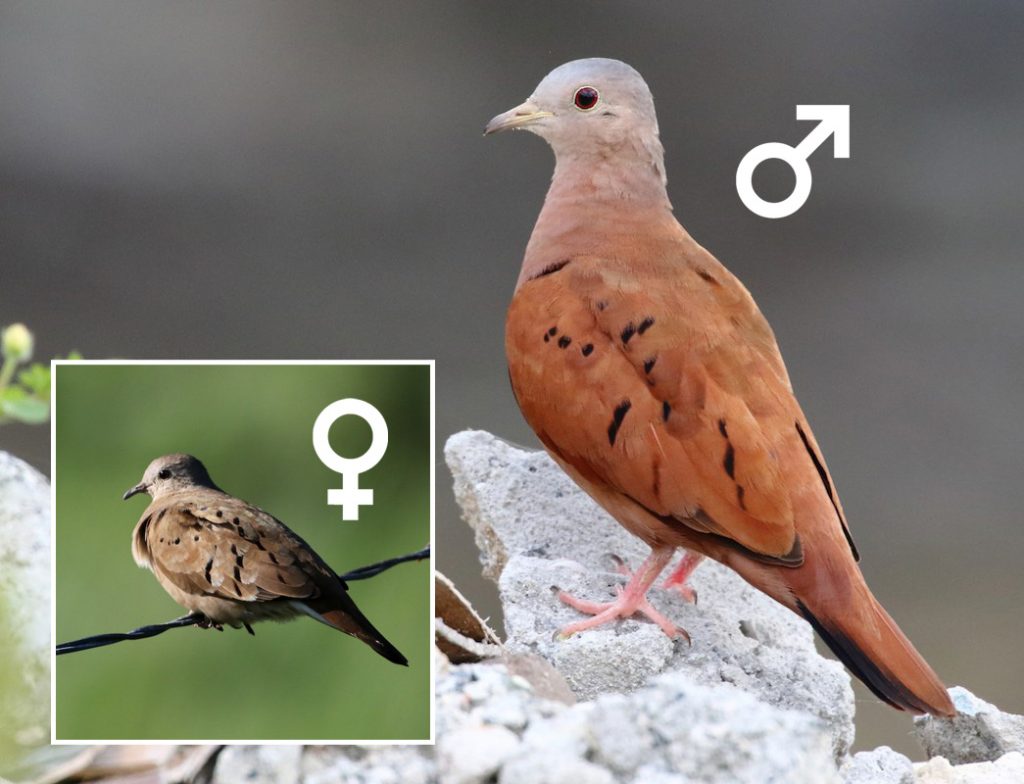
Ruddy Ground-Dove
Regional Species
The male Ruddy Ground-Dove has a bright ruddy plumage. This dove occupies many habitats including open fields, wet habitats, wet habitats, and even suburban yards. It forages in open areas to find seeds in the soil, the main food. It is a prolific breeder capable of reproducing year round. Due to its flexibility in habitat and its rapid reproduction, the Ruddy Ground-Dove is a common bird!
Range

Habitat
![]() The Ruddy Ground-Dove prefers open and humid habitats such as wetlands, riparian forest, logged areas, cultivated fields, and gardens. It requires open, bare ground to forage for seeds and thus avoids dense forests.
The Ruddy Ground-Dove prefers open and humid habitats such as wetlands, riparian forest, logged areas, cultivated fields, and gardens. It requires open, bare ground to forage for seeds and thus avoids dense forests.
Food
![]() he Ruddy Ground-Dove usually eats seeds that vary in size from 2-15 mm in length. Occasionally, it supplements its vegetarian diet with snails and insects.
he Ruddy Ground-Dove usually eats seeds that vary in size from 2-15 mm in length. Occasionally, it supplements its vegetarian diet with snails and insects.
Behavior
![]() The Ruddy Ground-Dove often forages in flocks and feeds side-by-side with other doves. It is a monogamous bird reproducing most of the year. Ruddy Ground-Doves have a strong pair bond. They rest next to each other on branches and share in mutual preening behavior. Both parents take care of the nestlings. Non-breeding individuals roost in social groups, which may also include other species of doves.
The Ruddy Ground-Dove often forages in flocks and feeds side-by-side with other doves. It is a monogamous bird reproducing most of the year. Ruddy Ground-Doves have a strong pair bond. They rest next to each other on branches and share in mutual preening behavior. Both parents take care of the nestlings. Non-breeding individuals roost in social groups, which may also include other species of doves.
Nesting
![]() The nests are usually built 1-2 m above the ground in trees or shrubs that are surrounded by vegetation. Most nests are built in the fork of a tree. Ruddy Ground-doves use abandoned nests from other birds as a substrate. Both sexes construct a sturdy, shallow cup nest made of straws, sticks, and roots. Nests typically contain two eggs, sometimes only a single egg and rarely three. Both sexes share incubating duties and feeding the young at the nest. Both parents provide crop milk and seeds to the nestlings.
The nests are usually built 1-2 m above the ground in trees or shrubs that are surrounded by vegetation. Most nests are built in the fork of a tree. Ruddy Ground-doves use abandoned nests from other birds as a substrate. Both sexes construct a sturdy, shallow cup nest made of straws, sticks, and roots. Nests typically contain two eggs, sometimes only a single egg and rarely three. Both sexes share incubating duties and feeding the young at the nest. Both parents provide crop milk and seeds to the nestlings.
Appearance
Size & Shape
The Ruddy Ground-Dove is a small dove, barely larger than a sparrow.
Color Pattern
Males are distinguished from other species of ground-doves by the bright ruddy plumage. Females are paler, tending more towards brown than ruddy tones, and are distinguished from females of similar species by the black spots on the wings, and lack of scaling. Juveniles are similar to females but with scaling.
Similar Species
Males, with their bright ruddy plumage, are distinctive. No other ground-dove has black underwing-coverts. The female resembles the Plain-breasted Ground-Dove, but is larger, more rufescent, and has even-colored undertail coverts as opposed to the mottled undertail coverts of Plain-breasted Ground-Dove. The female can also be distinguished from female Blue Ground-Dove by its smaller size and black spots on the wings. The female Common Ground-Dove is smaller, lacks the rufous coloring of Ruddy Ground-Dove, and has a speckled throat.
Did you know?!
Both sexes share incubating duties, with the male sitting in the morning through early afternoon, and the female sitting in the afternoon through the following morning.
Nest sites are defended from other Ruddy Ground-Doves. Doves attack intruders near the nest by beating the intruder with their wings, pecking, and chasing.
Birds sleep with their head pointing forward and bill tipped slightly downward.